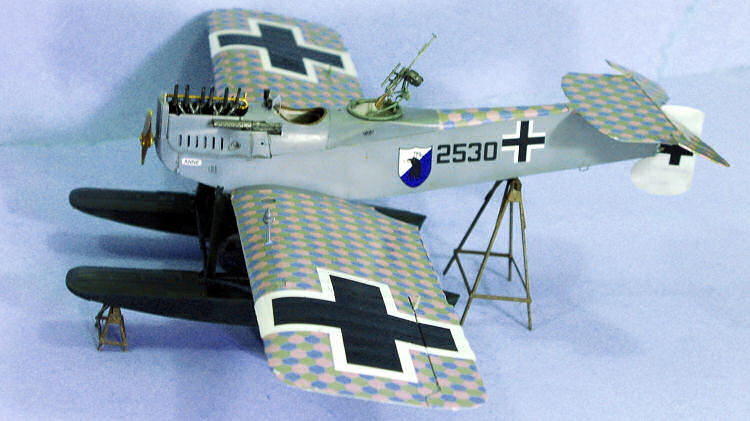
Wingnut Wings 1/32 Hansa-Brandenburg W.29
| KIT #: | 320010 |
| PRICE: | $89.00 SRP, includes shipping |
| DECALS: | Five options |
| REVIEWER: | Tom Cleaver |
| NOTES: |

| HISTORY |
The Hansa-Brandenburg W.29 is alleged to have been
designed one night on the back of a cabaret wine list by Chief Designer Ernst
Heinkel, and was essentially a monoplane redesign of the earlier
Hansa‑Brandenburg W.12 biplane.
The wing had nearly the wing area of the biplane, though
the advanced monoplane design had greatly improved performance due to the
reduction in drag.
This was achieved because the highly rigid nature of the
float and strut arrangement obviated the need for bracing wires.
 150hp Benz
Bz.
150hp Benz
Bz.
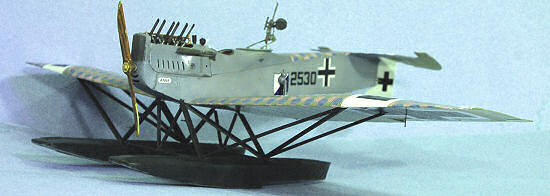
| THE KIT |
I first became aware of the Hansa-Brandenburg W.29 about
50 odd years ago when I found the Harleyford “Aircraft of the 1914-1918 War” in
the 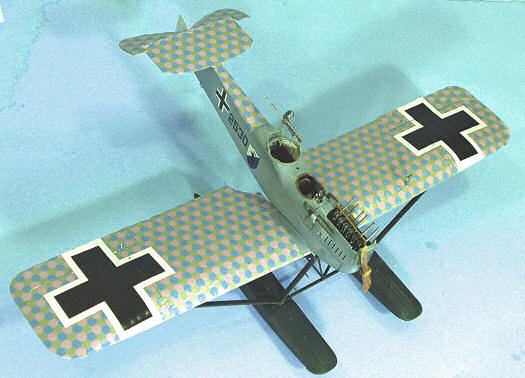 quite an
impact on me and I scratchbuilt a balsa model of it from the three-view drawing
in the book.
Since then the W.29 has always been one of my favorite Great War
airplanes.
It has appeared over the years in 1/72 scale, and Eduard released
a limited-run 1/48 kit back in 1998.
This kit by Wingnut Wings is the only one in 1/32 I am
aware of, and is easily the best kit of this airplane available in any scale.
quite an
impact on me and I scratchbuilt a balsa model of it from the three-view drawing
in the book.
Since then the W.29 has always been one of my favorite Great War
airplanes.
It has appeared over the years in 1/72 scale, and Eduard released
a limited-run 1/48 kit back in 1998.
This kit by Wingnut Wings is the only one in 1/32 I am
aware of, and is easily the best kit of this airplane available in any scale.
| CONSTRUCTION |
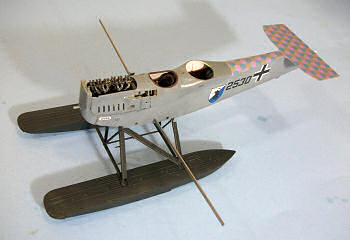 As with all Wingnut Wings kits, following the
instructions as they are done in the instruction booklet will insure a
successful outcome.
This kit does require some test-fitting of parts to
insure accurate final assembly; this is particularly true with the cowling
panels, where I found I had to do some filing of the fuselage area just ahead of
the cockpit to get a nice easy fit of the parts with the machine gun mounts.
Pay close attention to which aileron is used on which
wing, since the outer tip curves in a particular way for each.
It's also a good idea to pay attention to which wing
insignia is called for on which wing, so that you get the proper-fitting
insignia for the upper surface (I almost missed that myself).
As with all Wingnut Wings kits, following the
instructions as they are done in the instruction booklet will insure a
successful outcome.
This kit does require some test-fitting of parts to
insure accurate final assembly; this is particularly true with the cowling
panels, where I found I had to do some filing of the fuselage area just ahead of
the cockpit to get a nice easy fit of the parts with the machine gun mounts.
Pay close attention to which aileron is used on which
wing, since the outer tip curves in a particular way for each.
It's also a good idea to pay attention to which wing
insignia is called for on which wing, so that you get the proper-fitting
insignia for the upper surface (I almost missed that myself).
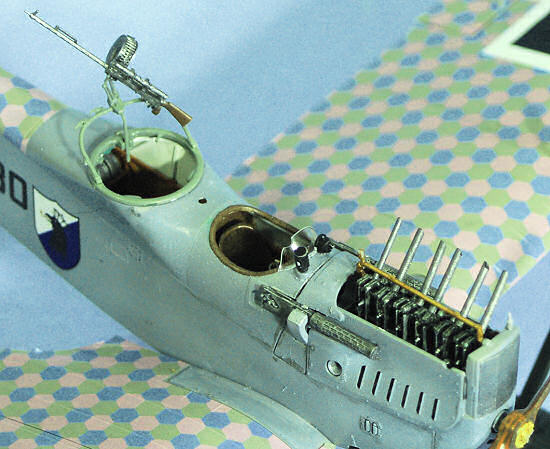
| COLORS & MARKINGS |
Painting:
 Ocean Grey;
I added in some white and “blotched” it to give a feeling of wear from
saltwater.
The lower surfaces of the wings and elevator were painted with
Gunze-Sangyo “Sail Color,” and the floats and struts were painted with Tamiya
“NATO Black.”
When that was finished, I gave the sub-assemblies an overall coat
of Xtracrylix “Clear Gloss.”
Ocean Grey;
I added in some white and “blotched” it to give a feeling of wear from
saltwater.
The lower surfaces of the wings and elevator were painted with
Gunze-Sangyo “Sail Color,” and the floats and struts were painted with Tamiya
“NATO Black.”
When that was finished, I gave the sub-assemblies an overall coat
of Xtracrylix “Clear Gloss.”
I started with the lozenge decals. You need to cut these close and pre-fit them where they will be applied, to make sure they fit, as they are not exact fits. I trimmed as necessary and applied the decals using copious amounts of Micro-Sol. After setting up overnight, the decals were nice and tight overall. I then attached the ailerons to the wings, and applied the national insignia and unit markings for the W.29 “2530", which is the most colorful option, carrying the markings of the Seastaffel Flanders II, operating from Zeebrugge in the summer of 1918. These decals went in without problem under Micro-Sol.
| FINAL CONSTRUCTION |
When the decals were set, I masked the engine cowling
panels and the cockpit cowlings, so they would stay with a gloss finish, and
applied a good coat of Xtracrylix “Clear Flat” to the rest of the fuselage, and
the floats and struts.
The wings, the lozenge on the upper surfaces of the
fuselage, stabilizer, and upper and lower surfaces of the elevator, were given a
coat of 
I attached the Spandaus to the fuselage, and also
attached the exhaust stacks for the engine at this point.
I then attached the floats to the fuselage with their
central struts.
This was followed by sliding the wings onto the metal spar and
attaching them, after which I attached the outer “N” struts for the floats.
I also attached the elevators and rudder, then finished
off by attaching the air speed indicator to the left wing.
I then did some “weathering” to the fuselage, with some
oil smears and such around the engine and cockpit, and some wear on the wing
walk, then attached the observer's gun ring and weapon.
Last but not least, the windshields and the prop were
attached.
I used RB productions 2BA wire for the control wires and
installed them per the kit instructions.
| CONCLUSIONS |
As I said above, this is the best kit of this
interesting airplane in any scale.
For those who are first venturing into the genre of
Great War models, this is an excellent first choice, since there is no rigging
to speak of other than the control wires.
The result is a distinctive-looking model for
any modeler who follows the instructions.
Those who want to detail the engine can have an even
more-distinctive model.
Highly recommended.
Review kit courtesy
of
Wingnut Wings.
If you would like your product reviewed fairly and quickly, please contact me or see other details in the Note to Contributors.